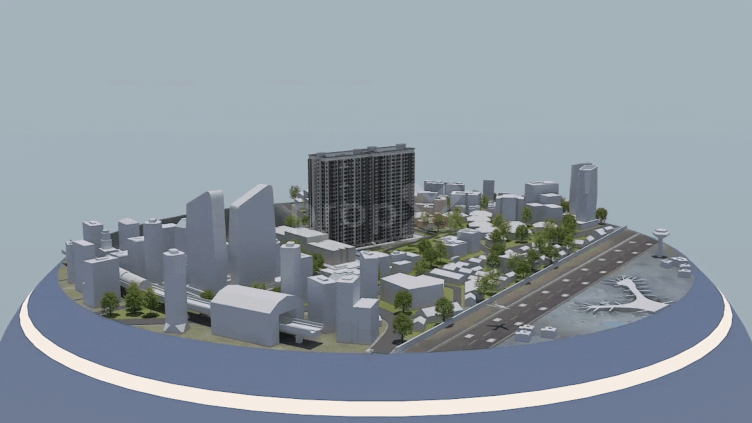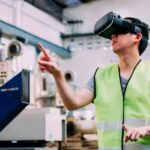Digital Twins are currently revolutionizing industries such as manufacturing, automotive, and energy. By utilizing data from sensors, Internet of Things (IoT) devices, artificial intelligence (AI), and cloud computing, these digital twins create a dynamic and interactive digital environment that mirrors the physical world. It’s astounding how this technology already transforms the way we work and live!

How Airports Can Unlock New Possibilities with Digital Twins
But now listen up: One of the emerging applications of digital twins is in the aviation sector, where airports can benefit from creating digital replicas of their infrastructure, operations, and services. Airports are complex systems that involve multiple stakeholders, processes, and technologies that need to be coordinated and integrated efficiently. Airports face various challenges such as increasing passenger demand, security threats, environmental regulations, operational costs, and customer satisfaction. By using digital twins, airports gain a holistic view of their current and future scenarios, identify potential issues and opportunities, and implement data-driven solutions.
In this article, we will explore how digital twins can be used to improve various aspects of airport management and performance, and how a state-of-the-art digital twin platform of an airport is required to transform any airport into an intelligent and sustainable hub.
How Digital Twins Benefit Airports
Digital Twins provide multiple benefits for airports across different domains such as design and planning, facility management, training and simulation, and passenger experience. Some of the business use cases are:
Design & Planning
Architects and engineers use the digital twin to visualize, analyze, and modify their designs in a realistic, interactive environment. This enables a better understanding of the designs and facilitates informed decision-making. For example, digital twins can help evaluate the impact of different design choices on energy consumption, carbon emissions, noise levels, passenger flow, and airport safety. Digital twins also support scenario planning and testing for future expansions or renovations of terminals.

EXPERT TIP: An airport regularly has all sorts of different 3D sources (BIM, photogrammetry, AutoCad files, laser scanning, lidar or 3D scanners). Isolated sources are of limited use, so the benefit lies in a collaborative 3D sourcing that supports and fuses them. The best choice today is a UNREAL Engine-powered digital twin that incorporates all these data layers from the various scattered 3D sources mentioned above.
Facility Management
Airport managers can use the digital twin to monitor and manage the airport’s various systems in real time. This enables proactive maintenance, reduces downtime and increases overall efficiency. For example, digital twins help detect anomalies or faults in equipment or infrastructure, predict maintenance needs based on usage patterns or environmental conditions, and optimise resource allocation and scheduling. Digital twins can also be integrated with other systems such as flight information, security cameras or weather forecasts to provide a complete operational picture.
Training & Simulation
Digital twins are used to create realistic training scenarios for airport staff. This would improve staff preparedness and enhance overall airport security. For example, digital twins can be used to train staff on how to operate new equipment or technology, how to deal with emergency situations or incidents, or how to comply with security protocols or regulations. Digital twins provide valuable feedback and assessment on staff performance and skills.

EXPERT TIP: Training and onboarding scenarios for new personnel are best created using AVATAR-based VR environments. This is the only way to train new employees in realistic scenarios. Anything else will usually fail due to a lack of realism.
Passenger Experience
Improving the passenger experience is key. How can you, as an airport operator, increase customer satisfaction? Passengers will undoubtedly use their smartphones or wearable devices to access the Airport City metaverse through augmented reality (AR) or virtual reality (VR) applications. They can then interact with the digital twin of the airport to receive personalised information or guidance about their flight status, gate location, baggage claim area or nearby amenities.
EXPERT TIP: Imagine you are an airport manager and you are exhibiting art. Why not let your passengers engage with it by exploring the airport’s art collection or other attractions through immersive experiences?
PropXX Digital Twin Platform for Airports
PropXX is a company that specialises in creating digital twin and metaverse solutions for various industries such as real estate, hotels, hospitality and aviation. PropXX’s platform combines 3D modelling, data integration and immersive technologies to create realistic and interactive digital environments.
PropXX is also creating digital twin platforms of airport cities that integrate the airport’s Building Information Modelling (BIM) data with PropXX’s metaverse technology. The metaverse technology allows users to interact with the digital twin through AR or VR applications.
The integration of PropXX’s digital twin and metaverse solutions with an airport’s BIM data ushers in a new era: This fusion of technologies enables airports to manage more efficiently, create a better passenger experience and ultimately lead any airport into a sustainable, digitally enabled future:
How PropXX Platform Can Empower Airports with Digital Twins
Operational Situational Awareness

- Monitor real-time passenger numbers to manage capacity and prevent overcrowding.
- Integration of flight information for real-time tracking and delay alerts.

- Real-time monitoring of vehicle and passenger movements for enhanced security.
Maintenance Management

- Real-time updating of work orders, with the ability to add labour hours and task completion status directly through the digital twin platform.

- Streamline maintenance processes for timely repairs and efficient asset management.
Planning, Simulation and Optimisation

- Run emergency scenarios to prepare for potential incidents and ensure safety.

- Plan and optimise gate operations using simulated aircraft movements.
- Create detailed plans for specialised areas, such as de-icing pads, based on real-time data and simulated scenarios.
Public Engagement
- Virtual representations of an airport’s art collection to the public.
3D Outdoor Reality Modelling

- Creation of a comprehensive 3D outdoor reality model of an airport and surrounding area to support operational efficiency and future planning.
These use cases are just a few of the many potential applications of PropXX’s digital twin and metaverse solutions. By incorporating real-time data and integrating it with existing systems, these solutions can deliver significant benefits in terms of operational efficiency and improved passenger experience.
Market Outlook and Growth Potential
The global digital twin market size was valued at $11.12 billion in 2022 and is expected to grow at a compound annual growth rate (CAGR) of 37.5% from 2023 to 2030. The aviation industry is one of the fastest growing segments in the digital twin market, as airports seek to leverage digital technologies to meet increasing passenger demand, environmental regulations, security challenges, and customer expectations.
According to a report by Future Travel Network, the global airport digital twin market is expected to grow at a CAGR of 42.1% from 2022 to 2027, reaching USD 4.5 billion by 2027.
Conclusion
Digital twins will be the key driver for the transformation of the aviation industry, enabling airports to create virtual replicas of their physical assets, processes and services. Digital twins will undoubtedly help airports improve their operational efficiency, enhance the passenger experience and meet their sustainability goals.
For any mid-sized airport, it is almost imperative to create a state-of-the-art digital twin platform that integrates the airport’s BIM data and existing 3D models into a unified, collaborative, immersive experience powered by metaverse technology.
The global airport digital twin market is expected to grow rapidly in the coming years, so if airport operators want to keep pace with the technology of the future, they need to start looking at digital twin technology now!
Quelle:


